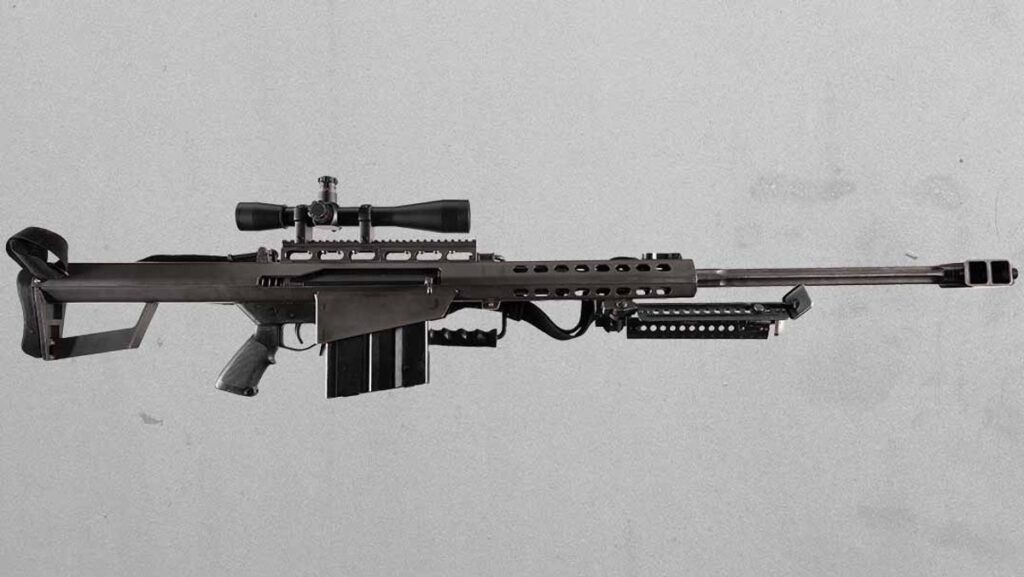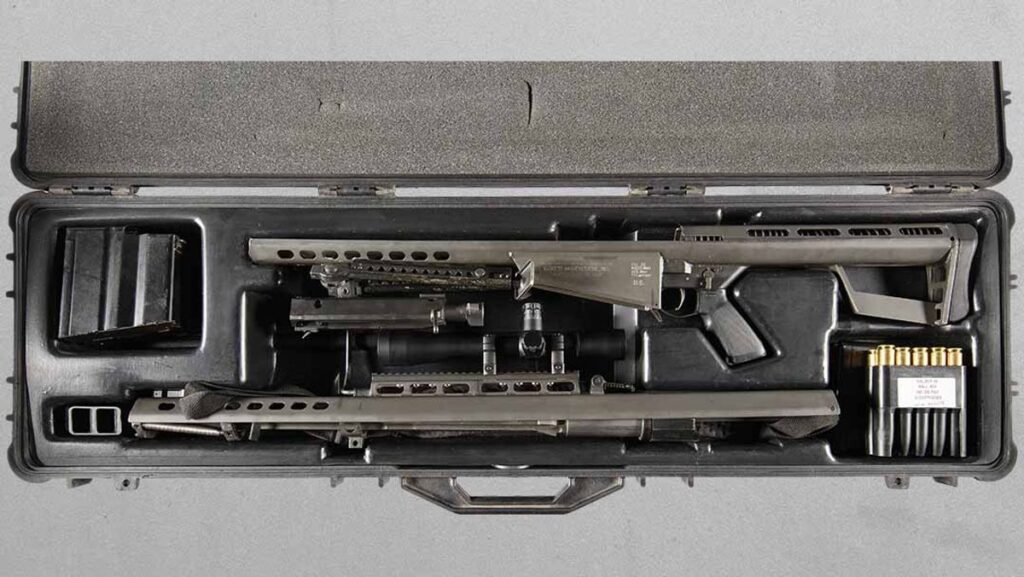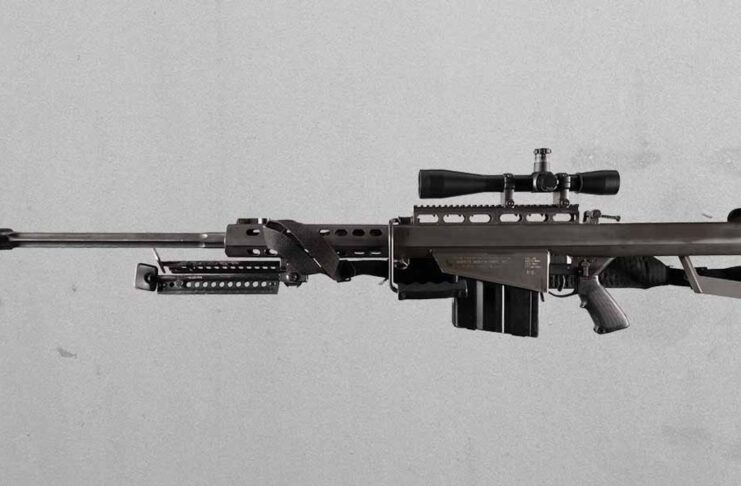The birth of the legendary Barrett M82 sniper rifle, is a fascinating American tale of inspiration, dedication, and innovation.
It's the story of a native Tennessean who would dream up the amazing M82 that would change modern warfare, be declared Tennessee's “official state rifle,” a designation it has held since 2016, and named one of the U.S. Army's “top 10 greatest inventions,” in 2005.
A Barrett M82A1 rifle documented as one of the first 100 shipped to U.S. Marines in the Gulf War theater for Operation Desert Storm is available in Rock Island Auction Company's upcoming May Premier Auction, May 19-21.
Birth of the Barrett M82
Ronnie Barrett was a professional photographer in the early 1980s in his hometown of Murfeesburo, Tenn. He got a call one fateful day from a company wanting photos of its military-style river patrol boat in action. The boat had two mounted .50 caliber machine guns. He snapped an award-winning photo that still hangs on the wall at Barrett Firearms Manufacturing in Murfreesboro, but it also gave him a burst of inspiration — could a shouldered rifle fire a .50 Browning Machine Gun (BMG) round?
He endeavored to find out. Shooters who shot .50 BMG rounds used converted anti-tank rifles like the Boys rifle or re-calibrated barrels of existing guns like bench rest rifles. The recoil could be pretty heavy and even injurious.
Barrett went home and despite having no background in engineering nor machining, he started sketching. He drew up three dimensional sketches and took it to local machinists but no one was interested in achieving Barrett's dream, save one. Working with that willing machinist, Don Mitchell, Barrett had a prototype in four months. Barrett said the first .50 BMG he ever fired was from one of his own rifles.
Barrett's gun could handle firing a .50 BMG round, but could a shooter handle firing it? After all, the .50 BMG round was intended to punch holes in buildings, vehicles, and bunkers.
The gun's size, being five feet long and weighing more than 28 lbs., would help with the recoil, but the design did most of the work. “The M82's reciprocating barrel and heavy twin return springs play a prominent role in mitigating the .50-caliber's horrible kick,” wrote Elwood Shelton in the July 2021 Gun Digest. An arrowhead-shaped muzzle brake that vents exhaust gas to the left and right was added later. A thick rubber recoil pad is on the back of the rifle butt, and the result of all these efforts was a recoil some shooters described as firing a 12 gauge shotgun. The gun had an effective range out to 1,800 meters.

Selling the Barrett M82
First, Ronnie Barrett had to perfect the action. The gun would fire a few times but then jam. He settled on a hex steel frame that improved reliability while also reducing bulk and made it the M82A1. He worked to make the manufacturing process more efficient, and by 1983 Barrett started selling the M82 commercially.
Early commercial sales were brisk despite the prohibitively high asking price ($5,895 in 1990) and Barrett quickly sold the first 30 he made but still lost money. Big gun fanciers liked what Barrett offered. Production kept up and Barrett went to the Association of the U.S. Army show in Washington, D.C. He drew interest from several countries, and Sweden put in the first order for 100 rifles in 1989. The Barrett M82A1 was off and running, even with a commercial price in 1990 of $5,895.
The CIA came calling. The agency quietly bought the guns to pass on to Afghan guerillas fighting the Soviets, figuring it gave them a long-range threat against the superior Soviet firepower. The U.S. Air Force wanted the Barrett M82 to clear runways of unexploded ordnance. In 1990, the U.S. Marine Corps placed an order for 125.

Then, Operations Desert Shield and Desert Storm happened, with the United States leading a coalition of countries to protect against the aggressions of Iraq and to push Saddam Hussein's troops out of Kuwait. Coalition troops that used the M82A1 were pleased at its vehicle stopping ability and being able to stop soft targets in the role of anti-materiel and anti-personnel weapon.
Legend of the Barrett M82
The U.S. Army adopted the Barrett M82A1 in 2003 as the M107 with an initial order of 2,142 and an option for 1,100 more. The gun saw plenty of action in Iraq and Afghanistan.
Snipers recorded kills from eye-popping distances, something .50 BMG guns are capable of doing. Marine sniper Carlos Hathcock recorded a kill at 2,460 yards using an modified, scoped M2 during the Vietnam War. Such unconventional weapons were no longer required with the prevalence and accuracy of the Barrett.

Despite its maximum effective range of 1,800 meters, snipers recorded kills at more than 2,000 meters. Army Specialist Nicholas Randstad eliminated a Taliban fighter from 2,288 yards. A U.S. Marine recorded a kill in Iraq from 1,614 meters in 2004. An Australian soldier using a Barrett M82A1 recorded a kill from 1.5 miles away in Afghanistan in 2012. Snipers using Barrett M82 rifles have recorded five of the 20 longest kills in history.
The Barrett was considered a combat multiplier because it could handle multiple tasks and also provide a psychological edge. Insurgents couldn't hide from the Barrett M82. Staff Sgt. Steve Reichert took out three Iraqis through a brick wall from a mile away using a Barrett M82 in 2004. An M82 given to Reichert by Barrett Firearms sold at Rock Island Auction in 2013.
According to U.S. Army reports from Operation Iraqi Freedom, the Barrett M82 “May have been the most useful piece of equipment for the urban fight.”
Once in a firefight in Afghanistan, a Barrett M82 misfired. The Marines operating it called Barrett customer service in Tennessee. The man who took the call, a former Marine, could hear gunfire in the background and quickly assessed the problem and provided a solution. The Marines were back in the fight in less than a minute. The story may be part urban legend since no date is every mentioned in the story's retelling, but the former Marine who took the call, Don Cook, has done on-camera interviews about the incident.
The M82 had a handful of variations. The M82A1M version improved on the A1 with a long picatinny-type rail and a rear grip and monopod socket. The M82A2 bullpup version didn't find much success, while the M82A3 is the rifle's U.S. Marine Corps designation. Of course, the official U.S. Army designation, M107 has already been mentioned.
The Barrett M82A1 was mentioned in a lawsuit filed by August 2021 by the Mexican government against 10 gun manufacturers as a favorite of drug cartels because of its hitting power. One was used in an assassination attempt on the Mexico City police chief that killed two bodyguards and a bystander.
“If you have a Barrett, it means that any non-special forces such as the local police and the municipal police cannot fight you,” Romain Le Cour Grandmaison, program director for the Mexico and Central America Office of Noria, a think tank, is quoted as saying in a Reuters article about the lawsuit. “That leaves the military as the only ones able to battle the cartels.”
The Irish Republican Army was also believed to have a couple in its arsenal at the time of the 2005 cease fire, while more than 60 countries list the Barrett M82 in their arsenals, showing how the rifle's stopping power is respected on all sides.

The Barrett M82A1 on offer is an impressive weapon, from its arrowhead-shaped muzzle brake to its rubber buttstock. The gun is fitted with a “SLAP” (Saboted Light Armor Penetrator) marked fluted barrel with a ventilated steel chasis, folding hooded blade front sight, a carry handle, scope base, and flip-up rear peep sight. The scope rail is a mid-90s military adjustment with a two-piece welded base and a one piece picatinny rail, and is topped with a Leupold Ultra16X-M1A scope. “U.S.” is stamped on the left side of the receiver below the patent number.
Subscribe for more great content!
The Barrett M82A1 brought a new dimension to modern warfare, by supporting close-in fighting with precision fire that can take out man and machine, and is in the arsenals of more than 60 militaries around the world. This specific example is listed on page 23 in Norman Chandler's “Death from Afar, Vol. 1” as one of the first 100 M82A1 rifles supplied to the U.S. Marine Corps for Operation Desert Shield in 1990. The original barrel is dated 2/91, so was sent from the factory to Saudi Arabia for distribution to military units and was likely in-theater for the combat phase. Operation Desert Storm started Feb. 24, 1991.
Modern military arms rarely find their way out of Uncle Sam's hands and into military arms collections. True to form, only about 35 of these rifles are known to be in private collections, placing this USMC-issued Barrett in rarified air. It will be on offer in Rock Island Auction Company's May 19-21 Premier Auction.
Sources:
The Barrett Model 82A1 Rifle, NRA American Rifleman
Barrett M82: Improbable Legend among Sniper Rifles, by Elwood Shelton, Gun Digest
Barrett M82: More than Sixty Countries Rely on This Sniper Rifle in Battle, by Kyle Mizokami; National Interest
How the Barrett M82 Became the U.S. Military's Sniper Rifle, by Peter Suciu, 19fortyfive.com
Barrett: 40 Years of .50-Caliber Authority, by John Zent, American Rifleman
`Weapon of War': The U.S. Rifle Loved by Drug Cartels and Feared by Mexican Police, by Diego Ore and Drazen Jorgic
This Marine Was The `American Sniper' of the Vietnam War,” by Blake Stillwell, We Are the Mighty
Read the original article in its entirety at rockislandauction.com.


